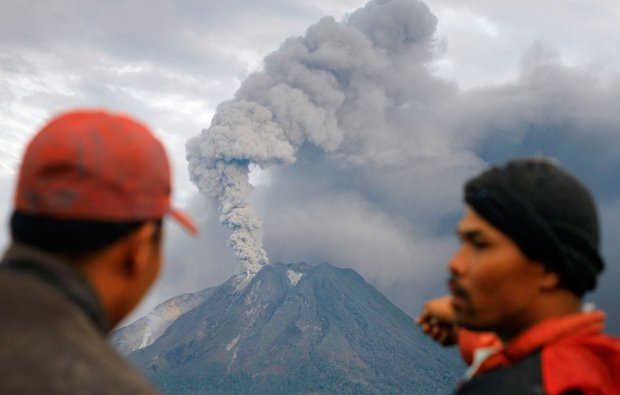30,000 evacuated as volcano erupts

TENS OF THOUSANDS OF people packed emergency shelters on Monday after a long-dormant volcano in northern Indonesia started to spew clouds of hot ash and smoke over several kilometres.
The eruption of Mount Sinabung, which as lain sleeping for 400 years, put the region on the highest alert level, and some domestic flights had to be diverted because of poor visibility. Villagers living along Sinabung’s fertile slopes in North Sumatra province started heading down the 2400 m volcano after it began rumbling during the weekend.
An explosion on Sunday was followed by a much more powerful blast Monday, and the number of people who evacuated hit 30,000, with hastily abandoned homes and crops blanketed in grey ash. The air was thick with the smell of sulphur.
Scientists “in the dark”
Sinabung last erupted in 1600, and officials acknowledged they had not been monitoring the volcano because it had been dormant for so long. “The nearest monitoring post to Sinabung is Mount Merapi – around 400 km to the southeast – so we were totally in the dark. We didn’t know anything until it started rumbling,” says Imam Simulingga, a government vulcanologist.
He noted that there are 129 active volcanoes to watch in Indonesia – a nation spread across 17,500 islands. It is prone to eruptions and earthquakes because of its on the so-called Ring of Fire – a series of fault lines around the Pacific slicing through New Zealand, Chile, the West Coast of the US, Japan and South-East Asia.
“We’ll be watching it closely from now on,” says Surono, another government vulcanologist. He says because eruption patterns have not been observed, “we really have no idea what to expect”. “We don’t know what set it off, how long it will continue or whether we should expect pyroclastic flows or more powerful eruptions,” added Surono, who, like many Indonesians, uses only one name.
Monitoring a volcano can include such techniques such as looking for seismic activity that indicates disturbances from rising magma, sampling gases, and looking for slight degrees of uplift in land, says Lee Siebert, director of the Global Volcanism Program at the Smithsonian Institution in Washington DC. He says it’s no surprise that Sinabung would erupt after 400 years of being quiet. That’s not very long by geological standards, Siebert says, noting that a volcano that has erupted within the past 10,000 years can be considered active.
Destructive potential
Like other volcanoes along the Sumatra fault line – the meeting point of the Eurasian and Pacific tectonic plates that have pushed against each other for millions of years – Sinabung has the potential to be very destructive. Magma forming inside the conical tip can act as a plug, allowing pressure to build up until it reaches bursting point.
“A volcano with a long repose period could deliver a more powerful eruption,” as was the case with Mount Pinatubo in the Philippines in 1991, which killed about 800 people, says Alain Bernard, a professor at the University of Brussels in Belgium. Sinabung could either go back to sleep or produce a series of blasts with increasing intensity, he says.
“A Pinatubo-size eruption is a rare event and unlikely to appear during the following days,” Alain says. “It takes normally weeks or months.” Although strong wind shifts or a powerful follow-up blast could affect air traffic in nearby Singapore and Malaysia, Transportation Ministry spokesman Bambang Ervan says only four domestic flights heading to the provincial capital of Medan were diverted so far.
Indonesia is home to some of the largest eruptions in recorded history. The 1815 explosion of Mount Tambora buried the inhabitants of Sumbawa Island under searing ash, gas and rock, killing an estimated 88,000 people. The 1883 eruption of Krakatoa could be heard 3200km away and blackened skies region-wide for months. At least 36,000 people were killed in the blast and the tsunami that followed.

